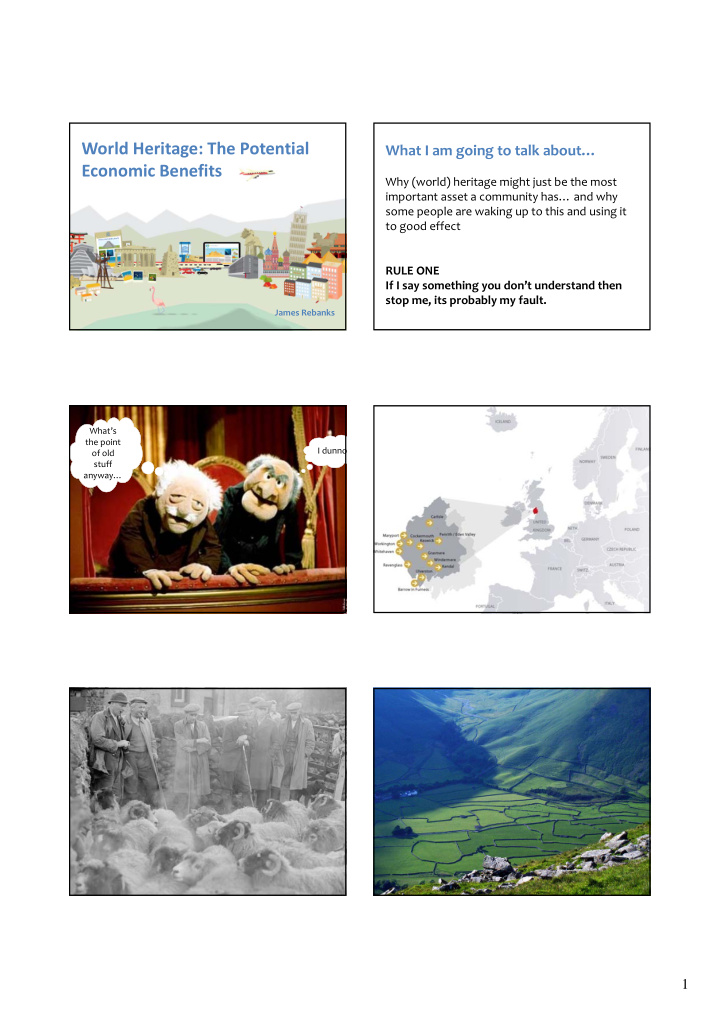



World Heritage: The Potential What I am going to talk about… Economic Benefits Why (world) heritage might just be the most important asset a community has… and why some people are waking up to this and using it to good effect RULE ONE If I say something you don’t understand then stop me, its probably my fault. James Rebanks What’s What’s the point I dunno of old stuff anyway… Source: 1
2
All he thinks about is Why should I support her UK’s nominated site in 2016… silly hobby? money But, like you, we have questions about it, and for the last ten years its been my business to answer them… What is this relationship? World Heritage Primarily answering this simple question… What good does this do (or can it do under Economic development certain circumstances) for businesses? Farms? Tourism? Cities? Regions? Do we really belong together? I’m not going to talk stats… 3
What do I know? “ Excellent piece of work ” ICOMOS “ Paradigm changing ” “ Very excellent ” UNESCO “Brilliant” NOKIA “Impressive” World Bank What is WHS for? Saving Stuff Emergency attention for unique heritage at risk Celebration Award Celebration/reward for heritage already preserved Another Logo Marketing/quality brand for historic places Place Making Catalyst for economic development using heritage How sites perceive WHS status matters Motivations matter… It can be a blocker or an enabler of change… Five lessons… WHS provides a set of tools… No Free Lunch But potential for benefit PR Value International media love it – makes it easy to know you matter The value of association The world’s leading companies want to be associated WHS Literacy Useful tool for attracting international high spending cultural visitors and spenders Cultural Glue Binding bits together into coherent product 4
Similar places have radically different outcomes from same thing… “We can do anything, we are world class” “We can’t do that here” “World Heritage sells… It’s that simple” 5
WHS literacy… The World’s Most Expensive Holiday… WHS literacy is linked to affluence… and has global reach Two year tour of 962 World Heritage Sites 157 countries £990,000 (for two people) (£7500 donation to UNESCO) (£50 membership fee) Idea: Simple. If you had unlimited funds you would want to see these places. Everything on the list is awesome. From a marketing perspective this matters… E.g. Bamberg Association? Your competitors for trade, talent and tourism… “Outstanding Universal Value” Globally endorsed specialness Avoiding the ‘Clone’ Trap – The ‘big shed’ theory of A crucial economic development issue economic development… “There are over 1,000 locations in Europe alone, all promoting exactly the same thing, looking identical and representing themselves in similar ways – through pictures of people playing golf, people in call centres, airplanes taking off. These places have become commodities, indistinguishable from one another and offering little or no added value”. 6
Culture/heritage/environment… as critical ingredients in placemaking 1) Strong economy ‐ 68% 2) Agreeable climate and environment – 67% Everywhere 3) Friendly local people – 66% now has the 4) Strong tradition in culture and the arts – 60% hardware… 5) Widely available entertainment/leisure – 60% you now need 6) Skills base/educated workforce – 58% 7) Exceptional architecture – 50% hardware + 8) Good public services – 46% 9) Attractive labour legislation ‐ 32% 10) Strong currency – 30% 11) Attractive employer legislation – 30% differentiation 12) Affordable housing – 28% 13) Sporting excellence – 26% 14) Celebrities in music, film and fashion – 22% Source: The Power of Destinations (Communications Group Plc) 15) Other 6% 7
Key trends… 1. The continuing growth of cultural tourism as a key sector of the tourism market – with 40% of European visitors now being ‘cultural tourists’ 2. The increasing need to differentiate tourism, investment destinations, or products from a homogenous mass of other ‘clone’ places and products – 92% of commercial decision makers say image and profile of locations becoming more important – 60% say culture becoming more important in decision making 3. The growing awareness among high value consumers of the World Heritage brand – with a marked growth in the use of the brand in the past 3 years 4. The growth of long ‐ haul tourism in the developing world, where our traditional cultural reference points are less effective and World Heritage is recognized – global quality marks/brands matter more than ever 5. Increased pressure (from the market and from changes to CAP) to find ways to add value to traditional farm businesses ‐ so they can continue to sustain the distinctive sense of place Abu Dhabi – A billion $ reminder… Authentic heritage ‐ some places have to buy it… Tourism New ideas from old buildings Jane Jacobs 8
Cultural tourists are more likely to be: New customers/first ‐ time visitors From geographically distant source markets Staying visitors and stay longer in a destination Respect, understand and engage meaningfully Engage in other travel and hospitality activities To spend more per trip than non ‐ cultural tourists Bamberg data… WHS as driver of higher value tourism WHS literacy… WHS literacy is linked to affluence… and has global reach Things to worry about… What have we got to get the world’s attention? What endorses our quality on the global stage? How do we raise profile in a changing world? Do we want other destinations to get this? From a marketing perspective this matters… E.g. Bamberg 9
Recommend
More recommend